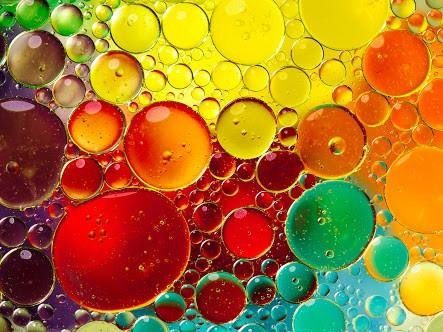Do You Know Why Oil and Water Don't Mix???
Oil and water don’t mix– they are described as ‘immiscible’. Crude oil floats on the sea after a spill from a tanker. Motor oil shows up as a sheen on puddles in the road. Olive oil separates out in salad dressing. But why don’t they mix?
What is Oil?
Oil is a slippery liquid that burns (is combustible) and is not soluble in water. Oil is used as a fuel (petrol is made from oil, and oil is used in some houses for heating) and to make things move easily (it is a lubricant). Oil can come from deep in the earth, or from plant or animal sources. Oil can also be made from chemicals (synthesised).
Why Don’t Oil and Water Mix?
Mix some food colouring into some water in a jar and pour a bit of vegetable oil in. Give it a good shake and leave it for a moment. At first it might look like it has mixed, and then small droplets of oil form, and join with other droplets to make larger and larger drops, until the oil settles on the top of the water.

Water molecules are polar – they have a small positive charge at one end and a small negative charge at the other end, and they stick to each other. Oil molecules are non-polar – they have no charge. Because of this, oil molecules are more attracted to each other than to water molecules, and water molecules are more attracted to each other than to oil molecules.
Oil and water can be forced to mix together by adding an emulsifier (see 'Making an Emulsion'). This creates a stable mixture of water with droplets of oil spread through it, or oil with droplets of water spread through it, that does not settle out.
Oil and Water have different densities
The first reason that water and oil don’t mix is because their molecules are packed differently. The molecules of water are packed very densely. (Would be good to show water molecules packed densely) In one glass of water, there are more molecules than the number of known stars in the universe!
This means if we take equal parts of water and oil, there will be more molecules of water than oil. This also means that it will always sink underneath the oil.
Why Does Oil Float?
Make a home-made lava lamp by filling a jar two-thirds full of water and put in some food colouring. Add some cooking oil. The oil will float on top of the water. Shake some salt onto the oil – it will form a blob and sink to the bottom. Once the salt dissolves, the oil will float back up to the top. If the oil doesn’t sink, sprinkle on a bit more salt.
The oil floats on top of the water because it is less dense (a spoonful of oil weighs less than a spoonful of water). The salt is denser than the water – it weighs the oil down and makes it sink. Once the salt dissolves in the water, the oil floats back up to the top of the water.
Make a glitter globe by filling a jar one-quarter full of surgical spirit, and then almost filling the jar with cooking oil. Drop in a few sequins and some glitter, or other small shiny things. Fill the jar right up to the brim with oil, and screw the lid on tightly. Shake the jar. The oil and alcohol will mix together and then separate, and the glitter and sequins will sparkle as they move around in the mixture.
The alcohol floats on top of the oil because it is less dense (a spoonful of alcohol weighs less than a spoonful of oil). Like water, alcohol is a polar molecule so does not mix with oil.
The Practical Side
Having an oily coat or oily feathers helps animals that live in rivers or the sea keep warm in cold water, because the oil keeps the water away from their skin.
Oil and water not mixing also means that crude oil spills from tankers stay on the surface of the sea. This makes the oil accessible to remove, but it also means that sea animals and birds get caught up in the oil, which weighs down their feathers and fur and is poisonous if they swallow it when they are trying to clean themselves.
Conclusion
There is one more reason why they cannot mix with each other. Polarity. Polarity means a molecule is positively charged at one end and negatively charged at the other. Water is a polar molecule. Water molecules are made up of two hydrogen atoms and one oxygen atom each.
Since only opposites attract, the water molecules stick to each other.
Polar molecules only dissolve in polar solvents. Similarly, non-polar molecules only dissolve in non- polar solvents. Oil is made up of non-polar molecules. It has a shell of negative charges, or electrons, surrounding the molecule.
The oil molecules will ultimately stick to each other. Therefore, even if you stir a container with oil and water, they will eventually separate into two distinct layers.
Source
Oil and Water have different densities

This post recieved an upvote from minnowpond. If you would like to recieve upvotes from minnowpond on all your posts, simply FOLLOW @minnowpond
Congratulations @moelflow! You have completed some achievement on Steemit and have been rewarded with new badge(s) :
Click on any badge to view your own Board of Honor on SteemitBoard.
For more information about SteemitBoard, click here
If you no longer want to receive notifications, reply to this comment with the word
STOPCongratulations @moelflow! You have completed some achievement on Steemit and have been rewarded with new badge(s) :
Click on any badge to view your own Board of Honor on SteemitBoard.
For more information about SteemitBoard, click here
If you no longer want to receive notifications, reply to this comment with the word
STOP